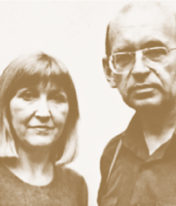Acceptance Speech
delivered by Hilla Becher
Your Royal Highnesses, Your Excellency, ladies and gentlemen, dear friends,
We are very pleased and very proud that this honour has been extended to us. Looking back from today, you might think that our work followed a straight line, based on a larger plan, a scenario as it were. However, there was never a commission nor ever even a request. That was a good thing, because otherwise no doubt it would have been dull. We simply made a start, not knowing exactly where we would end up.
The motivation was sentiment really. Bernd, who had grown up in Siegen among the mines and blast furnaces, wanted to place the images of his youth on paper. First he sketched and painted them, until he came to the decision to photograph them to achieve a more precise representation.
For me it was more a matter of youthful rebellion that I, after my childhood in Potsdam with all of its lovely palaces and parks, felt so drawn to the raw harbour and industrial settings.
The Ruhr area in the fifties boiled with energy, a spectacle of fire and steam and an overabundance of monstrous machines. Actually, it was only by working with these puzzling creatures that we came to understand them (I had a certain amount of difficulty with them in case). We also had to learn how best to depict them. Each one wanted to be recorded differently: the grasshopper differently than the octopus. Is there a front? Is there a back? Is there something like a face? What is characteristic? Certain fundamental forms, of course, were defined by function, by the period in which they were made, by economic conditions. Beauty was not of first importance, but the number of variations is surprising.
We worked as much as our means allowed us; that also defined distance at the time: first in Siegerland, after that in the Ruhr area, Holland, Belgium, Luxemburg, France. (In-between we had to earn some money now and again). A stipend from the British Council in 1966 allowed us to spend six months in England and Southern Wales; that was the most intensive work period for us to that date.
Ileana Sonnabend, who exhibited our photographs in 1972 in her gallery in New York, encouraged us to work in America as well, and she supported us generously in the following years. We were extremely pleased that she and Antonio Homem were able to be at the opening in the Stedelijk Museum. Manette Repriels is here today. We would like to thank Manette and Jacques Repriels for their help in Belgium and for their long friendship.
For the book that accompanies today’s occasion we would like to thank Susanne Lange of the Fotografische Sammlung, SK Stiftung Kultur. She has managed, through intelligent and painstaking work, to produce a beautiful book. It was published by Lothar Schirmer, a long-time friend; working with him is a pleasure. We are also grateful to him for publishing a whole series of our books without showing any signs of fatigue, which, given the fact that they were not destined to be bestsellers, was extremely brave.
We are not used to the idea of stopping our photographic work completely; we wish to still make a couple of trips. But we must concentrate primarily on processing the negatives, which for the most part were not printed for publications or exhibitions. We must also organize all the other things that we have collected – books, maps, plans, etc. -, catalogue and classify and cross reference them. Fortunately, there are computers and people who can do that very well. It will be nice if the archive can be accessible, readable and usable for others and for future generations who wish to work with the topic. The Erasmus Prize will help in that.
Please accept our sincerest thanks.
